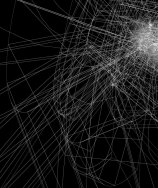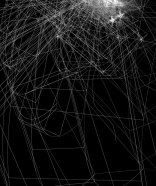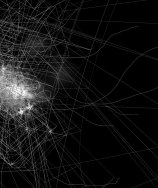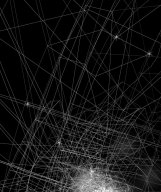Posts Tagged ‘Collaboration’
Imagination and Language Part 01: Solitude

copyright Moshe Ladanga 2007
I have long been an admirer of Rilke, first introduced to me by Katrin before she went on a seven-day trip to Sagada. The now-classic pocket-size Shambhala Press Edition of Letters was my first Rilke, and it was a gentle and subtly persuasive introduction to solitude, the core of my artistic practice.
To relish one’s ability to detach and contemplate things is not just a natural state, but a skill that needs to be nurtured and developed; it is a space that expands, no matter where you are in the world, no matter how you are in this life. I have treasured this gift and have even fought it.
So what does Rilke’s notion of the artistic practice have anything to do with the theoretical issues of imagination and language in art? I dare say it is the key issue, the unturned stone. The omnipresence of globalism and collaborative experiments in contemporary practices indirectly reinforce the need to slow down, to reflect, because the collective rush in my opinion is a quite human reaction to the tightening circle of information, of knowledge, not, as many are saying now, to the enthusiasm that “interconnected-ness” brings.
Yes, revolutions in art owe largely to the influx of difference, diversity, but institutionalizing a social phenomena will not only engender it, but kill it. Sometimes we forget that most theories come from observation, and this precious human facility is the one that takes time, and like a path in the woods, the riches of insight can only be gleaned after traversing the pattern of shadows.
It is an effort to be alone. Unlike the days before the internet, before cellphones, I find myself fighting constantly to be aware of my voice, to hear without prejudice the thoughts I have as I walk. Does anyone remember that fleeting subconscious moment that we have when we encounter a realisation- it felt like stepping into a light-struck place in a dense wood. Today, we often pick through our thoughts as one would pick through clothes; I must think this way, must not think like this.
Imagination and language cannot be deconstructed as Derrida would have brilliantly put it (by putting it to the page, inscribing it to form). Yes, there is an inextractable, even inscrutable connection, but once we look, one goes into gear. Arthur Koestler, one of my heroes, once described human consciousness as an essentially metaphorical one. As we try to make sense of what is outside of us, we already create- every moment is one of invention.
As an artist, this is important to me. No matter how many pedagogical branches grow from the current trend of specialised art theories, there will always be that moment of consideration, a beginning of a circle. It is the daily choice of stepping into it that I am keen on, and to keep it I have to know what is happening. To speak of what things are, one must see as one is.
Of Phenomena and Art: The Nature of Collaboration
We had the pleasure of having a tutorial session with Dr. Barbara Rauch, the acting director of Sciria. Just at the onset, it felt like it was going to be great, I mean if I could transcribe everything she said, I will. She confirmed a lot of our ideas and encouraged us with our investigation of perception and consciousness.
The first thing she said was that consciousness was a unique phenomena, because unlike other events studied by science, we can never observe it because we are at the center of it. But maybe through Art, we could express its intimations, its dimensions (if it even subscribes to measurement). It got me thinking about the research we have done on collaboration, and, with all the different artists, at times it seemed impossible to prove that collaboration was really happening. But the experience we have of working together on this project bears so much proof of the collaborative dynamic. We exchange words, we finish each other thoughts before one speaks it, we work towards the same idea but manifest it in different ways. The best instance I can cite is when we came up with the idea of the twin video loops, we were talking so fast that we got confused who said what and what was the idea again and what-the-fuck! (or maybe it was the continuous cups of coffee and never-ending swirls of nicotine clouds, haha)
For me, collaboration is also a phenomenon, especially between artists, because the currency of collaboration is ideas. As thoughts are spoken, eureka moments erupt, then the concepts you have running in your head changes immediately, imperceptibly. I try to imagine the process as a wheel, where once it is affected, it is altered permanently; it turns and we can only see (with our consciousness) what we think the idea is (that’s a strange loop right there).
Turning form 01
digital drawing
Moshe Ladanga
2008
This idea led me to thinking what the Theory of Relativity means; not that I’m going to do mathematical equations here, but the implications of Eisenstein’s insight, and how relevant and actually accurate Relativity describes this phenomena of thinking, of awareness. There is even a beauty in this, in where whatever attempts are made to study something, it must be made with a knowing that one pair of eyes and a brain is just that; as much as we want to believe we can sum up the world into a definitive system of forms, our idea of it will always be informed by how far or near we are to the thing we are trying describe.
This relativity also brings into relief the fallibility of our minds, but it does not mean it is a weakness; I think it is part of what it means to be alive, to be awake, to be curious. Things that we seek to discover will reveal themselves in the multiplicity of perspectives, and at the core of it that is what collaboration is all about.
Video Feedback: Projections
When we reviewed the experiments that utilized the 2 imacs in the studio, we realized that what was limiting the interactive experience of the piece was the size of the monitors. It was important for us to actually visualize the reflection of a more or less whole “Body”- by which I mean a reflected image that viewers can identify as their own.
We borrowed projectors and set up in the studio, waiting for the MA seminar room to be free. The effect of the projection is different, as you can see in the video below:
The weird thing though is that it looks better in the video than actually being there. In a darkened space, the interaction with the reflection is very limited; the eye is in a constant state of adjustment, and the saturation that is seen on the video documentation is less visible in the actual space.
It also felt like I was trying to induce a reaction with the shadow on the wall rather than being confronted with a self-reflection. The projected image just looked like pale imitations, and the image patterns that you see on the video was not that clear in the space.
But the thing that caught my eye was the repeating wave of light. In the part where the camera is centered on the projection, an interesting thing happens. The silver box (the electric outlet) near the bottom of the screen cast a ‘video shadow’ on the feed, causing a looping wave of light. In the space, it looked like an anomalous signal, and the frame of the screen disappears. Your eyes, because of the darkness, focus on the rhythmic pulse, and it hypnotizes you.
We still have to review this, and even though the projection setup can be beautiful, what we want for the work is the intimacy and the immediacy of seeing an image of yourself. Technical issues aside, what I learned from this setup is the pivotal role of the space; it does alter the experience of the work fundamentally.
Video Feedback: Part 01
This first test was taken with a handheld cam, but recorded on the Imac. The slight shifts of movement by my hand reveals the fluid geometry and delay of the feedback loop. The loop creates a strange virtual space, where the repetition of the frames suggest a corridor, but when our image intrudes, we are reminded of its illusion. This gets more clear in the second experiment below:
The effect on how we perceive is different when we are in front of a mirror, inspecting an image of ourselves. The effect is more like seeing your shadow, an objectification of the self-image. But watching the replications makes you aware of your body, as you try to match your movement (or more specifically, your awareness) of your image to the reflections on the screen.
The video below is different; found it in on youtube and it shows the video feedback that is native to TV. The cathode ray tube has different parameters, and if you observe the details of the image, these become apparent. The rate of delay, the timing of the transformation of colors is endemic to the technology of the tube- the millisecond firings of light to create a picture.
For our project, our focus is on the nature of self-conception through the image. Perhaps the flat screen offers a less complicated, and hopefully more direct way of revealing the dimensions of the experiential work.




